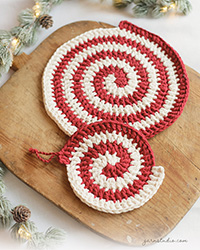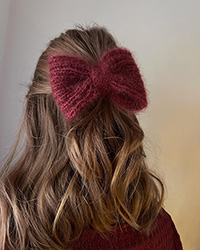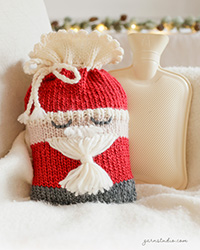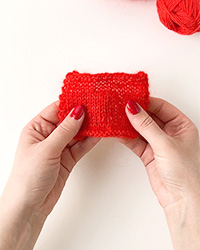How to make a gauge tension swatch
In this DROPS video we show how to knit a swatch to meausure gauge/tension.
Gauge/tension refers to the number of stitches in width and number of rows in height. This depends on which stitches used, what yarn, the needles/hook size and your own tension (i.e. how much yarn you allow between stitches).
The gauge can be adjusted to fit recommended gauge in a pattern by changing needle size. Larger needles produce a smaller gauge (fewer stitches per inch) and smaller needles produce a larger gauge (more stitches per inch).
Rib and cables pull in, giving more stitches per width than stockinette, garter or seed stitch. And garter or seed stitch have more rows per inch than stockinette.
Thicker yarns produce larger stitches (reducing the number of stitches per width and height).
Your gauge can also vary within a single garment (typically for beginners) and when you become more familiar with a pattern, you become more relaxed and make the stitch differently, producing a different gauge.
It's very important to check your gauge before starting a project to get the correct measures of the garment. A sample square (a swatch) is made in the stitch pattern and yarn used in the design. The swatch edges affect the reading of the gauge, so it's best that the swatch be at least 15x15 cm/ 6"x6" square. Swatching also makes you used to the stitch pattern, which will help you to a more even gauge in the final garment.
Gauge/tension refers to the number of stitches in width and number of rows in height. This depends on which stitches used, what yarn, the needles/hook size and your own tension (i.e. how much yarn you allow between stitches).
The gauge can be adjusted to fit recommended gauge in a pattern by changing needle size. Larger needles produce a smaller gauge (fewer stitches per inch) and smaller needles produce a larger gauge (more stitches per inch).
Rib and cables pull in, giving more stitches per width than stockinette, garter or seed stitch. And garter or seed stitch have more rows per inch than stockinette.
Thicker yarns produce larger stitches (reducing the number of stitches per width and height).
Your gauge can also vary within a single garment (typically for beginners) and when you become more familiar with a pattern, you become more relaxed and make the stitch differently, producing a different gauge.
It's very important to check your gauge before starting a project to get the correct measures of the garment. A sample square (a swatch) is made in the stitch pattern and yarn used in the design. The swatch edges affect the reading of the gauge, so it's best that the swatch be at least 15x15 cm/ 6"x6" square. Swatching also makes you used to the stitch pattern, which will help you to a more even gauge in the final garment.
Patterns using this technique
Change language: English (UK/cm)
Video #108, listed in: Other techniques, Extra Tips
Our videos do not have sound. We are a worldwide company and our videos are watched by people speaking endless of different languages and many do not understand English. So since there is not a given language for us to use, we instead have written instructions to accompany the video, and then there is no sound to disturb while watching.
You can adjust the speed of this video by clicking on the icon, on the play bar.






















Audrey wrote:
Je n'ai jamais vraiment pris le temps de faire des échantillons. Je suis toujours impatiente de commencer un nouveau modèle, alors je ne voulais pas m'embêter à faire un échantillon. Je crois finalement que je vais m'en préoccuper d'avantage, ne serait-ce que pour avoir les bonnes dimentions! ;)
16.07.2011 - 04:52